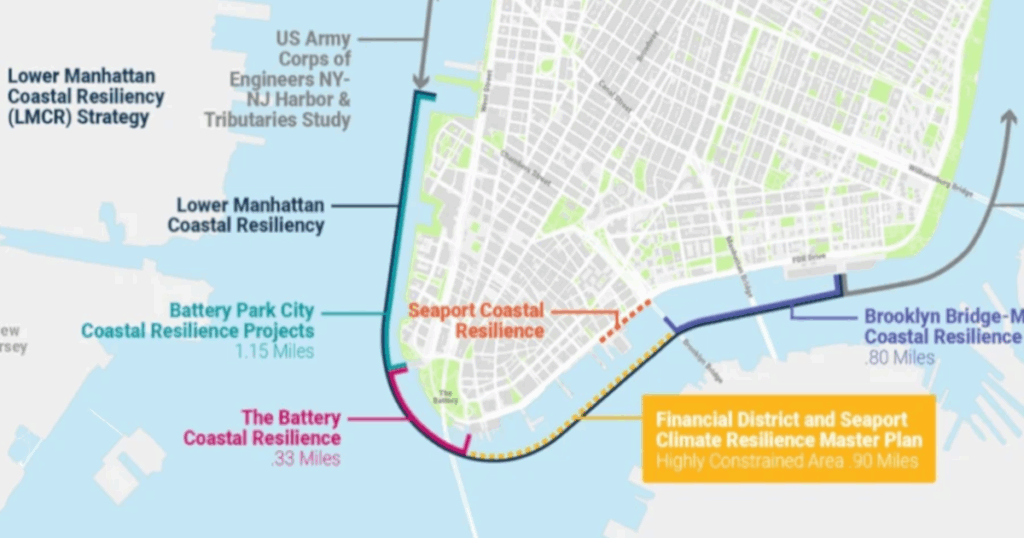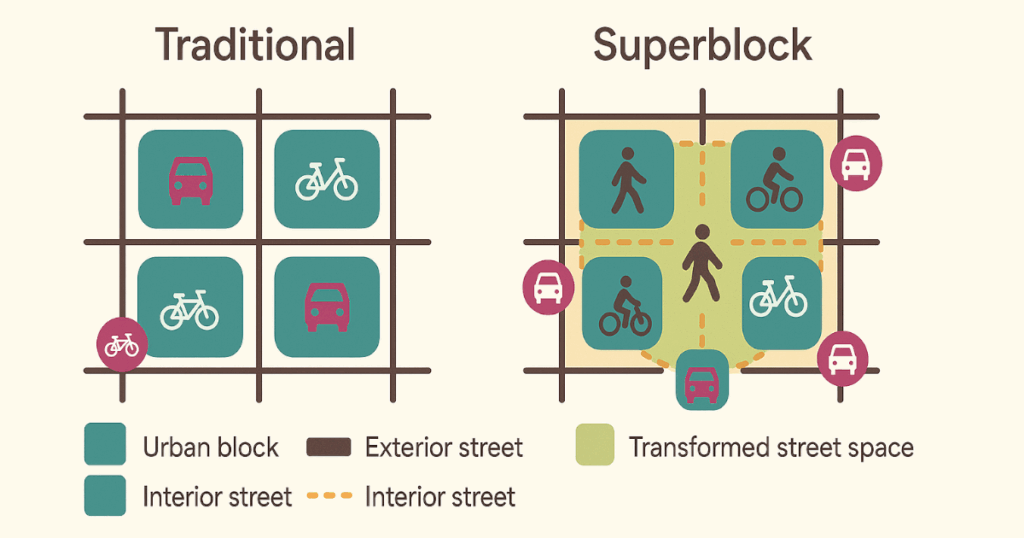Here’s our latest newsletter about the big projects and ideas shaping the cities of tomorrow.
You Should Know
- China is currently grappling with an unprecedented heatwave, marked by its early onset and intensity. Temperatures have surged past 40°C (104°F) across northern and central China, with several cities setting new records for the hottest May on record.
- U.S. interest rates are spiking amid growing concerns over unsustainable federal deficit spending and Moody’s recent downgrade of U.S. government debt. The 10-year Treasury yield, which influences interest rates on all kinds of consumer and commercial loans, climbed to 4.6%, its highest level since February.
- The world’s youngest capital city by population age is Kampala, Uganda’s capital, with 4.3 million inhabitants. Approximately 48% of its residents are under the age of 15.
Worth Watching
- The Ellinikon: Athens’ grand regeneration project.
- Exploring the extreme engineering of the world’s tallest hotel.
- The plan to fix America’s most critical rail tunnel.
Top Stories

NYC’s Resilience Plan to Save Lower Manhattan
Manhattan, home to America’s most valuable real estate per square foot, faces escalating threats from climate change. Hurricane Sandy’s devastation in 2012, which caused nearly $20 billion in damage, underscored the particular vulnerability of Lower Manhattan. Projections indicate that without intervention, the Financial District and Seaport could face monthly flooding by the 2050s, escalating to daily occurrences by the 2080s.
To address these challenges, the Lower Manhattan Coastal Resiliency initiative is underway. It comprises four integrated projects designed to strengthen Lower Manhattan’s physical and economic resilience by embedding flood protection into the fabric of the community. With an estimated total cost of up to $7 billion, the initiative spans 3.5 miles, stretching from the Two Bridges neighborhood to Battery Park City.
The largest and most ambitious of the four efforts is the Financial District and Seaport Climate Resilience Master Plan. With a projected cost of $5.4 billion, it proposes extending the shoreline by up to 500 feet into the East River—marking the first significant expansion of Manhattan’s shoreline in over 50 years. The new shoreline will feature a multi-level waterfront with a continuous flood barrier, public open space, and upgraded utilities. Conceptual planning is complete, and the city is now advancing detailed design and environmental review phases.
In Battery Park, which occupies the southern tip of Manhattan, construction is already underway. This includes raising Wagner Park by up to 12 feet and installing deployable flood barriers and modernized drainage systems. The Brooklyn Bridge–Montgomery Coastal Resilience project, which protects the densely populated Two Bridges neighborhood, centers on a network of approximately 90 flip-up flood gates—some reaching 13 feet tall. These gates lie flat under normal conditions but automatically rise during extreme storms to form a continuous flood barrier. Construction began in 2023 and also includes storm drainage upgrades, resilient landscaping, and pedestrian improvements.
Together, these projects represent one of the most ambitious and comprehensive coastal resiliency efforts in the U.S.—a critical investment in safeguarding New York City’s future.
Waymo Races Ahead in the Robotaxi Market
Waymo, Alphabet Inc.’s autonomous driving subsidiary, has achieved a significant milestone by completing 10 million paid robotaxi rides, doubling its lifetime total in just five months. This rapid growth underscores the increasing integration of autonomous vehicles into daily transportation. Waymo’s services are operational in major U.S. cities, including Austin, Los Angeles, Phoenix, and San Francisco.
The company’s expansion is bolstered by regulatory approvals, such as the recent green light from the California Public Utilities Commission to operate in San Jose. Additionally, Waymo has formed a partnership with Toyota Motor Corp. to develop self-driving technology aimed at personal vehicle ownership.
In the global robotaxi landscape, Waymo’s primary competitors include Baidu’s Apollo Go, Pony.ai, and Tesla. Baidu’s Apollo Go has completed over 11 million rides since its launch in 2019, with 1.4 million rides in the first quarter of 2025 alone. Pony has reported a 200% year-over-year increase in robotaxi services and an 800% surge in fare-charging revenues, indicating significant growth in their operations. Tesla plans to launch a trial of its robotaxi service in Austin, Texas, by the end of June 2025, starting with around 10 self-driving vehicles in designated areas.
Regarding fleet size, Waymo operates over 1,500 autonomous vehicles. The company plans to add 2,000 more vehicles by 2026, aiming for a total fleet size of 3,500. Pony aims to expand its robotaxi fleet to about 1,000 vehicles by the end of 2025,
Looking ahead, Waymo plans to expand its services to additional cities, including Atlanta, Miami, and Washington, D.C., by 2026. The company is also investing in a new autonomous vehicle factory in Metro Phoenix, in partnership with Magna, to support the growing demand for its services. This facility is expected to produce over 2,000 new Jaguar I-PACE vehicles equipped with Waymo’s autonomous technology next year. These strategic initiatives underscore Waymo’s commitment to scaling its operations and shaping the future of transportation.
The Myth of 100% Renewable Energy
Many cities proudly claim to run on 100% renewable energy—but that headline often masks a more nuanced picture.
When cities say they are powered by 100% renewable energy, they usually refer only to the electricity used by municipal operations or the grid electricity consumed within city limits. This figure typically excludes major energy uses such as heating, cooling, industrial processes, and transportation—sectors still largely powered by fossil fuels. As a result, a city’s total energy mix is often far from fully renewable.
A key tool in these claims is the Renewable Energy Certificate (REC). An REC is a market-based instrument that certifies one megawatt-hour of electricity was generated from a renewable source and added to the grid. Cities can buy RECs to match their electricity consumption, effectively outsourcing the production of clean energy without changing their actual energy supply. In reality, the physical electricity powering their homes, offices, and streetlights may still come from fossil fuel sources nearby. While RECs support the growth of renewable energy overall, their use can give a misleading impression of local sustainability.
Only a few places, like Reykjavik, Iceland, and Basel, Switzerland, come close to true 100% renewable energy use across all sectors. Reykjavik benefits from abundant geothermal and hydro resources, while Basel draws from extensive hydropower and integrates sustainability into all energy policies. Both cities also strongly support sustainable transportation—Reykjavik is expanding electric vehicle infrastructure, and Basel boasts one of the highest public transit usage rates in Europe.
The distinction between grid-based claims and total energy use matters—especially in an era of climate accountability.

Barcelona’s Superblocks Are Redesigning City Living
Barcelona’s superblocks are transforming urban life by reclaiming streets from cars and prioritizing people. First introduced in 2016 in the Poblenou neighborhood, superblocks (superilles) are designed to reduce traffic, pollution, and noise while increasing green space and community interaction. Despite initial resistance, the model has gained widespread support and is now central to the city’s urban planning strategy. See ariel views of superblocks here.
A superblock typically consists of nine city blocks arranged in a 3×3 grid. Through-traffic is restricted within this area, allowing only local residents, emergency vehicles, and deliveries at reduced speeds. The reclaimed space is repurposed for pedestrians, cyclists, playgrounds, and greenery, creating a more livable and sustainable environment. This design not only enhances mobility for non-motorized users but also fosters social engagement among residents.
The benefits of superblocks are significant. In the Sant Antoni superblock, nitrogen dioxide (NO₂) levels decreased by 25%, and particulate matter (PM10) levels dropped by 17% . Noise levels were reduced from 65 dB to 35 dB, improving the quality of life for residents . Additionally, the reduction in traffic has led to increased walking and cycling, contributing to better public health outcomes.
Barcelona plans to expand the superblock model significantly. The city aims to implement 503 superblocks by 2030, transforming one in three streets in the Eixample district into green corridors . This ambitious plan has inspired other cities worldwide, including Los Angeles, Buenos Aires, and Melbourne, to explore similar urban interventions. The superblock model demonstrates how thoughtful urban design can create healthier, more sustainable, and more connected communities
Big Deals
- Crusoe secures $11.6 billion to build OpenAI’s Texas data center.
- The Nuclear Company secures $51.3 million to develop a fleet of nuclear reactors.
- Luminar, a company that specializes in LIDAR, secures up to $200 million.
- RXR is set to acquire Manhattan’s 590 Madison Ave for $1.1 billion.
- SparkCharge raises $30 millionto expand mobile EV fleet charging services.
- Mesirow raises over $1.2 billion for U.S. apartment fund.
Extra Reads
- U.S. home construction has already declined significantly due to tariffs.
- China accelerates Pakistan dam construction amid India’s water supply threats.
- NYC aqueduct’s $2B repair delayed; completion expected post-2027
- Toyota and BYD are launching affordable electric vehicles for everyone.
- Carlyle introduces Revera Energy to develop clean infrastructure projects in Australia and the UK.
- Denver advances proposal eliminating minimum parking requirements for new developments.
- Tesla’s self-driving program lags behind Waymo’s by years.
- Dubai launches PropTech Hub, aiming to support 200 companies.
- China plans unified land-use mapping to enhance urban renewal efforts.
- BYD surpasses Tesla in European EV sales for April.
- Higher lumber prices threaten U.S. home affordability crisis.